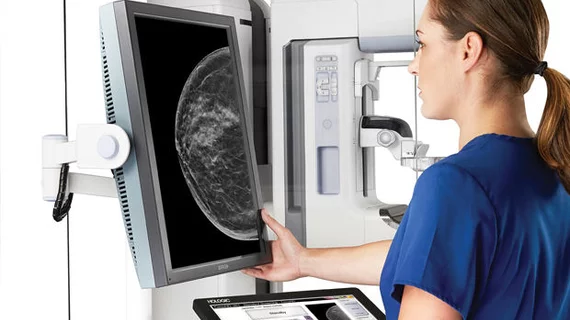Radiologists with less than a decade’s worth of experience and lower annual reading volumes are more likely than their colleagues to have higher mammography recall rates, according to research published in the Journal of the American College of Radiology.
“Critics of mammography focus on its high false-positive rate, particularly as U.S. recall rates increase,” first author Catherine S. Giess, MD, of the Center for Evidence-Based Imaging at Harvard Medical School and Brigham and Women’s Hospital, and co-authors wrote in the journal. “Screening recall rate is a 2018 quality benchmark in the Merit-Based Incentive Program at CMS, and is being incorporated into proposals for bundled payment plans.”
Mammography recall rates in the U.S. vary, Giess and colleagues said, though the Breast Cancer Surveillance Consortium has in the past reported a mean recall rate for 359 radiologists of 11.6 percent. Forty percent of participating clinicians also failed to meet ACR benchmarks for recalls, which justify rates no higher than 12 percent.
Recall rates, alongside cancer detection rates and the positive predictive value of abnormal results on screening exams, are all performance and program quality metrics for mammography practices, the authors said. And excessive recalls don’t just affect individual organizations—they can also have major implications for patients.
“Unnecessary recalls generate health costs, are associated with psychological morbidity and may alter subsequent screening behavior,” Giess et al. wrote. “Combining low recall rates with high cancer detection rates would optimize screening benefits versus morbidities.”
Because reported patient and radiologist characteristics affecting recall rates have differed across clinical studies, Giess and her team at Brigham and Women’s conducted a large-scale retrospective study of 61,198 mammograms, which were interpreted by 13 breast imaging specialists between 2012 and 2015.
The researchers collected patient demographics via the electronic medical record, breast density and BI-RADS score using natural language processing and risk aversion, and information about stress from uncertainty and malpractice concerns with a survey. Radiologist characteristics, like annual screening volume and clinical experience, were also calculated.
Overall, Giess and colleagues said, 5,678 exams were recalled—9.3 percent of the total pool. Lower reading volumes and fewer years of clinical experience predicted higher recall rates in radiologists, while patients who were younger or had denser breasts also saw higher rates. The team found no correlation between higher recall rates and cancer detection rates, nor did radiologist concerns about potential malpractice claims, stress or individual risk tolerance affect recall rates in any way.
“After adjusting for patient, examination and radiologist factors associated with higher odds of screening mammography recall, we found no residual unexplained recall rate variation among breast imaging specialists at a large academic practice,” the authors wrote.
The researchers’ findings were in line with previous studies, which have found screening recall rates in the U.S. to be much higher than in places like Europe, despite similar cancer detection rates between the locations. Giess et al. said that gap could have something to do with lower U.S. minimum reading volumes and higher U.S. recall rate benchmarks, because Americans allow a recall rate of up to 12 percent while Europeans insist that rate remain below 5 percent.
The fact that U.S. screening guidelines are voluntary could contribute, the authors wrote, since Europe’s guidelines are “rigorous” and mandatory. Malpractice threats are also more prevalent in the States.
Reviewing possible recalls from less experienced physicians and increasing annual reading volumes could help the U.S. level with its ally across the Atlantic, Giess and co-authors said.
“Our findings refute the theory that there may be an unmeasurable characteristic of radiologists that makes them inclined to call mammographic findings abnormal,” they wrote. “This has favorable implications for reducing recall rate variability.”

